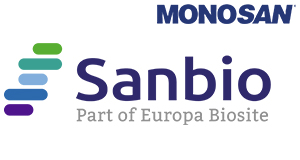Mouse anti-Mouse TNF-alpha, clone V1q (Monoclonal)
Mouse anti-Mouse TNF-alpha, clone V1q (Monoclonal)
Artikelnummer
SANMON9060
Verpackungseinheit
1 ml
Hersteller
Sanbio / Monosan
Verfügbarkeit:
wird geladen...
Preis wird geladen...
Clone Number: V1q
Immunogen: Unknown or proprietery to MONOSAN and/or its suppliers
Concentration: 100 ug/ ml
Storage buffer: PBS with 0.1% BSA and 0.02% sodium azide
Additional info: The monoclonal antibody V1q recognizes mouse tumor necrosis factor alpha (TNF-α). TNF-α is the prototype cytokine of the family of TNF-related ligands, which are based on structural and functional homologies. TNF-α is synthesized as type II transmembrane protein. TNF-α can be recognized by two different membrane receptors, namely TNF-R1 and TNF-R2. TNF-α is present in a membrane-bound (tmTNF) as well as soluble form (sTNF). The membrane-bound form of TNF-α is recognized by both TNF receptors with high affinity, whereas the soluble form is recognized more superiorly by TNF-R1. TNF-α is produced by many different cell types including macrophages, T lymphocytes, NK cells, neutrophils and endothelial cells. Cells differ in the expression of the two TNF-receptors and sTNF versus tmTNF, respectively. TNF-α, a homotrimeric 17 kDa protein, is a potent mediator of inflammatory and metabolic functions. TNF-α was originally detected as a highly cytotoxic cytokine for tumor cells, it causes tumor necrosis in vivo and shows cytolytic activity against tumor cells in vitro. Furthermore, TNF-α has been implied as central mediator in shock induced by gram negative micro-organisms. TNF-α induces on its turn the production of many other cytokines. Furthermore, TNF-α has been found in inflammatory foci such as synovial effusions in rheumatoid arthritis, systemic circulation in septic shock, parasitemia and rejection of renal transplants. The monoclonal antibody V1q recognizes both natural and recombinant TNF-α and shows neutralizing activity.
References: Echtenacher; B et al. J Immunol 1990; 145: 3762/Gerspach, J et al Microsc Res Tech 2000, 50: 243/Demjen; D et al. Nat Med 2004; 10: 389
Immunogen: Unknown or proprietery to MONOSAN and/or its suppliers
Concentration: 100 ug/ ml
Storage buffer: PBS with 0.1% BSA and 0.02% sodium azide
Additional info: The monoclonal antibody V1q recognizes mouse tumor necrosis factor alpha (TNF-α). TNF-α is the prototype cytokine of the family of TNF-related ligands, which are based on structural and functional homologies. TNF-α is synthesized as type II transmembrane protein. TNF-α can be recognized by two different membrane receptors, namely TNF-R1 and TNF-R2. TNF-α is present in a membrane-bound (tmTNF) as well as soluble form (sTNF). The membrane-bound form of TNF-α is recognized by both TNF receptors with high affinity, whereas the soluble form is recognized more superiorly by TNF-R1. TNF-α is produced by many different cell types including macrophages, T lymphocytes, NK cells, neutrophils and endothelial cells. Cells differ in the expression of the two TNF-receptors and sTNF versus tmTNF, respectively. TNF-α, a homotrimeric 17 kDa protein, is a potent mediator of inflammatory and metabolic functions. TNF-α was originally detected as a highly cytotoxic cytokine for tumor cells, it causes tumor necrosis in vivo and shows cytolytic activity against tumor cells in vitro. Furthermore, TNF-α has been implied as central mediator in shock induced by gram negative micro-organisms. TNF-α induces on its turn the production of many other cytokines. Furthermore, TNF-α has been found in inflammatory foci such as synovial effusions in rheumatoid arthritis, systemic circulation in septic shock, parasitemia and rejection of renal transplants. The monoclonal antibody V1q recognizes both natural and recombinant TNF-α and shows neutralizing activity.
References: Echtenacher; B et al. J Immunol 1990; 145: 3762/Gerspach, J et al Microsc Res Tech 2000, 50: 243/Demjen; D et al. Nat Med 2004; 10: 389
| Artikelnummer | SANMON9060 |
|---|---|
| Hersteller | Sanbio / Monosan |
| Hersteller Artikelnummer | MON9060 |
| Verpackungseinheit | 1 ml |
| Mengeneinheit | STK |
| Reaktivität | Mouse (Murine) |
| Klonalität | Monoclonal |
| Methode | Flow Cytometry, Functional Assay |
| Isotyp | IgG1 |
| Wirt | Mouse |
| Konjugat | Unconjugated |
| Produktinformation (PDF) | Download |
| MSDS (PDF) |
|

 English
English







